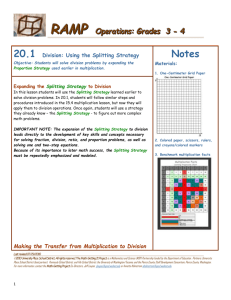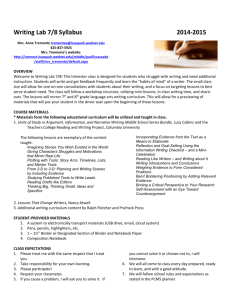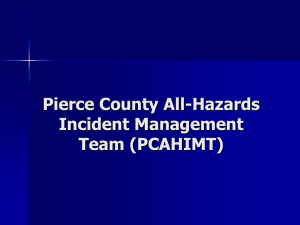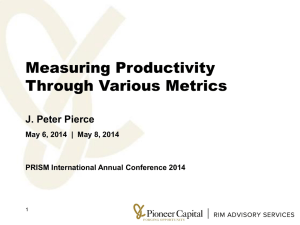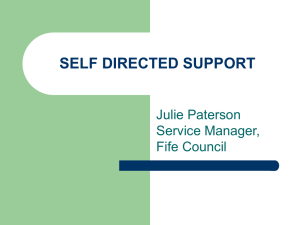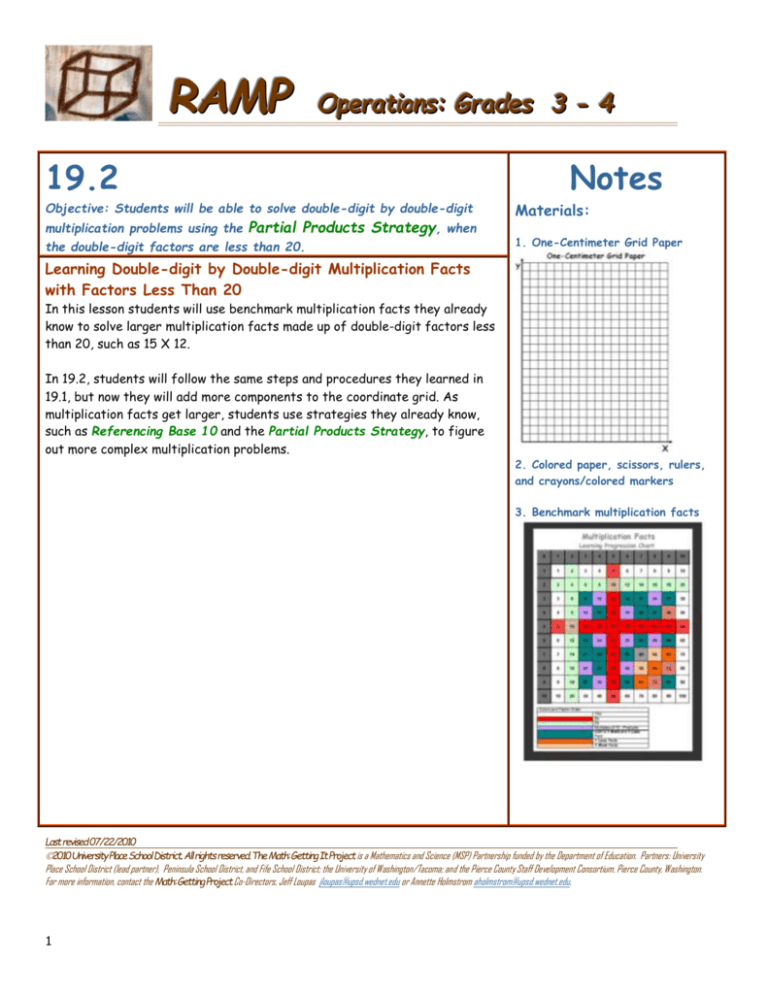
RAMP
Operations: Grades 3 - 4
19.2
Notes
Objective: Students will be able to solve double-digit by double-digit
multiplication problems using the Partial Products
the double-digit factors are less than 20.
Strategy, when
Materials:
1. One-Centimeter Grid Paper
Learning Double-digit by Double-digit Multiplication Facts
with Factors Less Than 20
In this lesson students will use benchmark multiplication facts they already
know to solve larger multiplication facts made up of double-digit factors less
than 20, such as 15 X 12.
In 19.2, students will follow the same steps and procedures they learned in
19.1, but now they will add more components to the coordinate grid. As
multiplication facts get larger, students use strategies they already know,
such as Referencing Base 10 and the Partial Products Strategy, to figure
out more complex multiplication problems.
2. Colored paper, scissors, rulers,
and crayons/colored markers
3. Benchmark multiplication facts
Last revised 07/22/2010
2010 University Place School District. All rights reserved. The Math: Getting It Project is a Mathematics and Science (MSP) Partnership funded by the Department of Education. Partners: University
Place School District (lead partner), Peninsula School District, and Fife School District; the University of Washington/Tacoma; and the Pierce County Staff Development Consortium, Pierce County, Washington.
For more information, contact the Math:Getting Project Co-Directors, Jeff Loupas jloupas@upsd.wednet.edu or Annette Holmstrom aholmstrom@upsd.wednet.edu,
1
RAMP
Operations: Grades 3 - 4
ASK Now that we know how to figure out problems such as
12 X 6, what if the second factor is also a double-digit
number? For example, what if we had the problem 14 x 12?
How could we use multiplication facts and strategies we
already know to figure out this problem?
SHOW students 14 X 12 on the coordinate grid, and label.
SAY First, let’s graph it on the coordinate grid the same
way we did before. Remember that the factors are the
length of each side of a rectangle. In this problem, the first
factor is 14, and goes on the x axis. The second factor is
12, and goes on the y axis. These labels correspond to the
coordinate pair, labeled on the upper right hand corner.
Last revised 07/22/2010
2010 University Place School District. All rights reserved. The Math: Getting It Project is a Mathematics and Science (MSP) Partnership funded by the Department of Education. Partners: University
Place School District (lead partner), Peninsula School District, and Fife School District; the University of Washington/Tacoma; and the Pierce County Staff Development Consortium, Pierce County, Washington.
For more information, contact the Math:Getting Project Co-Directors, Jeff Loupas jloupas@upsd.wednet.edu or Annette Holmstrom aholmstrom@upsd.wednet.edu,
2
RAMP
Operations: Grades 3 - 4
SHOW students how to illustrate 14 X 2 on the coordinate grid.
Note: Remind students that the first factor always goes on the
x axis, and the second factor always goes on the y axis. Label this fact above the
upper right corner. Continue to model and reinforce this standardized way
of illustrating multiplication facts on the coordinate grid to ensure that students and
the teacher are always drawing the same pictures in the same way.
ASK Do you see any 10s facts you already know in this
larger problem? (10 x 10 = 100).
SHOW 10 X 10 = 100 by coloring in or cutting out a rectangle to represent
10 X 10 = 100 and label, asking questions such as How long is the x side
of the 10s fact rectangle (10)? How long is the y side of
the 10s fact rectangle? (10).
Last revised 07/22/2010
2010 University Place School District. All rights reserved. The Math: Getting It Project is a Mathematics and Science (MSP) Partnership funded by the Department of Education. Partners: University
Place School District (lead partner), Peninsula School District, and Fife School District; the University of Washington/Tacoma; and the Pierce County Staff Development Consortium, Pierce County, Washington.
For more information, contact the Math:Getting Project Co-Directors, Jeff Loupas jloupas@upsd.wednet.edu or Annette Holmstrom aholmstrom@upsd.wednet.edu,
3
RAMP
Operations: Grades 3 - 4
SAY This is the same thing we did before for double-digit
by single-digit multiplication, only now there is extra area on
BOTH sides of our 10s fact.
ASK So now let’s look at the extra area on the right side of
the rectangle, on the x axis. If the x side of the 10s fact
rectangle is 10, how many more are left? (4) So do you see
any other 10s facts we already know in the area that’s left?
(4 X 10 = 40)
SAY That’s right: we also have the 10s fact 4 X 10 = 40.
So you have two 10s facts, side by side on the x axis.
This is just like what we did earlier when learning
multiplication facts in Lesson 15, using the More Area
Compare Strategy. In 19.1, we used the same strategy
when we began to break problems down by 10s, which is
what links the graph to the algorithm:
10 X 14 = 10 X 10 + 10 X 4. This also clearly illustrates
the distributive property.
Last revised 07/22/2010
2010 University Place School District. All rights reserved. The Math: Getting It Project is a Mathematics and Science (MSP) Partnership funded by the Department of Education. Partners: University
Place School District (lead partner), Peninsula School District, and Fife School District; the University of Washington/Tacoma; and the Pierce County Staff Development Consortium, Pierce County, Washington.
For more information, contact the Math:Getting Project Co-Directors, Jeff Loupas jloupas@upsd.wednet.edu or Annette Holmstrom aholmstrom@upsd.wednet.edu,
4
RAMP
Operations: Grades 3 - 4
SHOW 4 X 10 by coloring in or cutting out a rectangle to represent
4 X 10 = 40, and label.
SAY So we have four more groups of 10 on the X axis, for a
total of 14 groups of 10.
SAY/ASK Now let’s look at the extra area above our original
10s fact, on the y axis. Do you see any other 10s facts we
already know in the area that’s left?
(10 X 2 = 20).
SHOW 10 X 2 = 20 by coloring in or cutting out a rectangle to represent
10 X 2 and label it.
Last revised 07/22/2010
2010 University Place School District. All rights reserved. The Math: Getting It Project is a Mathematics and Science (MSP) Partnership funded by the Department of Education. Partners: University
Place School District (lead partner), Peninsula School District, and Fife School District; the University of Washington/Tacoma; and the Pierce County Staff Development Consortium, Pierce County, Washington.
For more information, contact the Math:Getting Project Co-Directors, Jeff Loupas jloupas@upsd.wednet.edu or Annette Holmstrom aholmstrom@upsd.wednet.edu,
5
RAMP
Operations: Grades 3 - 4
SAY So we have two more groups of 10 on the y axis, for a
total of 12 groups of 10. Again, this is what we did earlier
when learning multiplication facts in Lesson 15, using the
More Area Compare Strategy. In 19.1, we used the same
strategy when we began to break problems down by 10s,
which is what links the graph to the algorithm:
10 X 12 = 10 X 10 + 10 X 2. This also clearly illustrates
the distributive property.
SAY/ASK Now let’s look at what’s left. Are there any 10s
facts left? No.
SAY/ASK So what about single-digit facts: do you see
any single-digit facts in what’s left? (4 X 2 = 8)
SHOW 4 X 2 = 8 by coloring in or cutting out a rectangle to represent
4 X 2 and label it.
Last revised 07/22/2010
2010 University Place School District. All rights reserved. The Math: Getting It Project is a Mathematics and Science (MSP) Partnership funded by the Department of Education. Partners: University
Place School District (lead partner), Peninsula School District, and Fife School District; the University of Washington/Tacoma; and the Pierce County Staff Development Consortium, Pierce County, Washington.
For more information, contact the Math:Getting Project Co-Directors, Jeff Loupas jloupas@upsd.wednet.edu or Annette Holmstrom aholmstrom@upsd.wednet.edu,
6
RAMP
Operations: Grades 3 - 4
SAY/SHOW: So now that we have the entire problem on the
coordinate grid, all we have to do is add up the Partial
Products starting with the single-digit product:
4 X 2
10 X 2
4 X 10
10 X 10
=
8
= 20
= 40
= 100
128
So 14 x 12 = 128.
Last revised 07/22/2010
2010 University Place School District. All rights reserved. The Math: Getting It Project is a Mathematics and Science (MSP) Partnership funded by the Department of Education. Partners: University
Place School District (lead partner), Peninsula School District, and Fife School District; the University of Washington/Tacoma; and the Pierce County Staff Development Consortium, Pierce County, Washington.
For more information, contact the Math:Getting Project Co-Directors, Jeff Loupas jloupas@upsd.wednet.edu or Annette Holmstrom aholmstrom@upsd.wednet.edu,
7
RAMP
Operations: Grades 3 - 4
SAY So when you have a larger, double-digit by double-digit
problem with factors less than 20, you can figure it out by
following these steps:
Partial Product STEPS for double-digit by doubledigit multiplication facts with factors less than 20:
1. GRAPH the larger problem on the coordinate grid, making
sure the first factor is on the x axis and the second factor
is on they axis. Label the problem.
2. Look for the largest 10s fact you already know (10 x 10)
within the larger problem, color it in, and label it.
3. Look for another 10s fact you already know in the area
that’s left on the x axis, color it in, and label it.
4. Look for another 10s fact you already know in the area
that’s left on they axis, color it in, and label it.
5. Look for a single-digit fact you already know in the area
that’s left, color it in, and label it.
6. Starting with the single-digit product, ADD the products
of all four parts together to find the product of the larger
problem.
Note: When students add up the partial products it is important to follow the same
order the algorithm procedure follows. In a double-digit by double problem, start with
the single-digit fact, and then add the 10s fact next to it, then the 10s fact below the
single-digit fact, and then finally the largest 10s fact:
Last revised 07/22/2010
2010 University Place School District. All rights reserved. The Math: Getting It Project is a Mathematics and Science (MSP) Partnership funded by the Department of Education. Partners: University
Place School District (lead partner), Peninsula School District, and Fife School District; the University of Washington/Tacoma; and the Pierce County Staff Development Consortium, Pierce County, Washington.
For more information, contact the Math:Getting Project Co-Directors, Jeff Loupas jloupas@upsd.wednet.edu or Annette Holmstrom aholmstrom@upsd.wednet.edu,
8
RAMP
Operations: Grades 3 - 4
SAY So let’s practice with the multiplication fact 12 X 13.
SHOW students 12 X 13 on the coordinate grid, and label.
SAY First, let’s graph it on the coordinate grid the same
way we did before.
ASK Do you see our largest known 10s fact, 10 X 10 = 100,
in this problem? Yes.
Last revised 07/22/2010
2010 University Place School District. All rights reserved. The Math: Getting It Project is a Mathematics and Science (MSP) Partnership funded by the Department of Education. Partners: University
Place School District (lead partner), Peninsula School District, and Fife School District; the University of Washington/Tacoma; and the Pierce County Staff Development Consortium, Pierce County, Washington.
For more information, contact the Math:Getting Project Co-Directors, Jeff Loupas jloupas@upsd.wednet.edu or Annette Holmstrom aholmstrom@upsd.wednet.edu,
9
RAMP
Operations: Grades 3 - 4
SHOW 10 X 10 = 100 by coloring in or cutting out a rectangle to
represent 10 X 10 = 100, and label.
SAY/ASK Now let’s look at the extra area on the right side
of the rectangle, on thex axis. Do you see any other
10s facts we already know in the area that’s left?
Yes -
2 X 10 = 20.
Last revised 07/22/2010
2010 University Place School District. All rights reserved. The Math: Getting It Project is a Mathematics and Science (MSP) Partnership funded by the Department of Education. Partners: University
Place School District (lead partner), Peninsula School District, and Fife School District; the University of Washington/Tacoma; and the Pierce County Staff Development Consortium, Pierce County, Washington.
For more information, contact the Math:Getting Project Co-Directors, Jeff Loupas jloupas@upsd.wednet.edu or Annette Holmstrom aholmstrom@upsd.wednet.edu,
10
RAMP
Operations: Grades 3 - 4
SAY That’s right: we also have the 10s fact 2 X 10 = 20.
SHOW/SAY 2 X 10 = 20 by coloring in or cutting out a rectangle to
represent 2 X 10 = 20, and label.
So we have two 10s facts, side by side:
10 X 10 = 100
2 X 10 = 20
Last revised 07/22/2010
2010 University Place School District. All rights reserved. The Math: Getting It Project is a Mathematics and Science (MSP) Partnership funded by the Department of Education. Partners: University
Place School District (lead partner), Peninsula School District, and Fife School District; the University of Washington/Tacoma; and the Pierce County Staff Development Consortium, Pierce County, Washington.
For more information, contact the Math:Getting Project Co-Directors, Jeff Loupas jloupas@upsd.wednet.edu or Annette Holmstrom aholmstrom@upsd.wednet.edu,
11
RAMP
Operations: Grades 3 - 4
SAY/ASK Now let’s look at the extra area above our original
10s fact. Do you see any other 10s facts we already know in
the area that’s left?
Yes -
10 X 3 = 30
SHOW 10 X 3 = 30 by coloring in or cutting out a rectangle to represent 10
X 3 and label it.
SAY/ASK Now let’s look at what’s left. Are there any 10s
facts left? No.
Last revised 07/22/2010
2010 University Place School District. All rights reserved. The Math: Getting It Project is a Mathematics and Science (MSP) Partnership funded by the Department of Education. Partners: University
Place School District (lead partner), Peninsula School District, and Fife School District; the University of Washington/Tacoma; and the Pierce County Staff Development Consortium, Pierce County, Washington.
For more information, contact the Math:Getting Project Co-Directors, Jeff Loupas jloupas@upsd.wednet.edu or Annette Holmstrom aholmstrom@upsd.wednet.edu,
12
RAMP
Operations: Grades 3 - 4
SAY/ASK So what about single-digit facts: do you see any
single-digit facts in what’s left? Yes: 2 X 3 = 6.
SHOW 2 X 3 = 6 by coloring in or cutting out a rectangle to represent 2 X
3 and label it
Last revised 07/22/2010
2010 University Place School District. All rights reserved. The Math: Getting It Project is a Mathematics and Science (MSP) Partnership funded by the Department of Education. Partners: University
Place School District (lead partner), Peninsula School District, and Fife School District; the University of Washington/Tacoma; and the Pierce County Staff Development Consortium, Pierce County, Washington.
For more information, contact the Math:Getting Project Co-Directors, Jeff Loupas jloupas@upsd.wednet.edu or Annette Holmstrom aholmstrom@upsd.wednet.edu,
13
RAMP
Operations: Grades 3 - 4
SAY/SHOW: So now that we have the entire problem on the
coordinate grid, all we have to do is add up the four parts:
2 X 3 = 6
10 X 3 = 30
2 X 10 = 20
10 X 10 = 100
156
So 12 x 13 = 156.
DO Have students continue practicing double-digit by double-digit
multiplication problems in partial product format, above, using teens numbers
(do not put any 2s in the 10s column yet).
Last revised 07/22/2010
2010 University Place School District. All rights reserved. The Math: Getting It Project is a Mathematics and Science (MSP) Partnership funded by the Department of Education. Partners: University
Place School District (lead partner), Peninsula School District, and Fife School District; the University of Washington/Tacoma; and the Pierce County Staff Development Consortium, Pierce County, Washington.
For more information, contact the Math:Getting Project Co-Directors, Jeff Loupas jloupas@upsd.wednet.edu or Annette Holmstrom aholmstrom@upsd.wednet.edu,
14
RAMP
Operations: Grades 3 - 4
Partial Products Strategy STEPS for Double-Digit
Multiplication:
SAY So when you have a larger, double-digit problem, you
can figure it out by following this 5 step process. As you
complete each step, identify the corresponding area we
shaded on the coordinate grid.
1. Multiply the factors in the 1s column first (2 X 3 = 6) and put the 6
below the line.
2. Next you can multiply the 10 in the top number by the 3 in the
bottom number (10 X 3 = 30) and put the answer, 30, below the 6.
3. Then you can multiply the 2 in the top number by the 10 in the
bottom number (2 X 10 = 20), and put that below the 30.
4. Then you can multiply the 10 in the top number by the 10 in the
bottom number (10 X 10 = 100), putting that below the 20. Students
should be able to point to where this product is shaded in on the
coordinate grid.
5. Finally you would add these partial products all together. The answer
is 156, which is really just the same thing we did on the grid, only
without the pictures.
Last revised 07/22/2010
2010 University Place School District. All rights reserved. The Math: Getting It Project is a Mathematics and Science (MSP) Partnership funded by the Department of Education. Partners: University
Place School District (lead partner), Peninsula School District, and Fife School District; the University of Washington/Tacoma; and the Pierce County Staff Development Consortium, Pierce County, Washington.
For more information, contact the Math:Getting Project Co-Directors, Jeff Loupas jloupas@upsd.wednet.edu or Annette Holmstrom aholmstrom@upsd.wednet.edu,
15
RAMP
Operations: Grades 3 - 4
Finding Missing Pieces
SAY Once we know how to solve multiplication problems using
the grid, it is easy to figure out what is missing in a problem
when one of the pieces in the partial products is left out.
SHOW students the problem 14 X 12 on the grid, with one
of set of labels missing:
ASK So how could we figure out what the missing piece is,
based on what we DO know? How could we figure out the
length of the sides of the missing rectangle?
The length of the side on the y axis is 12, and we already have 10 from our 10
X 10 area, leaving 2 on that side. And we know the bottom side of the
unidentified rectangle is 10, because it has to be the same length as our 10 X
10 rectangle. So that means the unidentified rectangle is 10 X 2 = 20.
Last revised 07/22/2010
2010 University Place School District. All rights reserved. The Math: Getting It Project is a Mathematics and Science (MSP) Partnership funded by the Department of Education. Partners: University
Place School District (lead partner), Peninsula School District, and Fife School District; the University of Washington/Tacoma; and the Pierce County Staff Development Consortium, Pierce County, Washington.
For more information, contact the Math:Getting Project Co-Directors, Jeff Loupas jloupas@upsd.wednet.edu or Annette Holmstrom aholmstrom@upsd.wednet.edu,
16
RAMP
Operations: Grades 3 - 4
DO Have students continue practicing finding missing parts of coordinate
grid representations of multiplication problems using the rest of the doubledigit teen numbers. You can have a complete piece missing, same as the
example; the labels or a multiplication or a product inside one of the pieces
can be missing; or one of the partial products, for example, the 8, 20, 40, and
100 in the partial product algorithm on the right, can be missing.
Having students practice identifying these missing pieces solidifies the
connection between both representations, and reinforces the relationship
between relative size and value. It provides students with a way to make sure
they have all components in a math problem, as well, and improves their
ability to identify a reasonable answer.
Last revised 07/22/2010
2010 University Place School District. All rights reserved. The Math: Getting It Project is a Mathematics and Science (MSP) Partnership funded by the Department of Education. Partners: University
Place School District (lead partner), Peninsula School District, and Fife School District; the University of Washington/Tacoma; and the Pierce County Staff Development Consortium, Pierce County, Washington.
For more information, contact the Math:Getting Project Co-Directors, Jeff Loupas jloupas@upsd.wednet.edu or Annette Holmstrom aholmstrom@upsd.wednet.edu,
17
RAMP
Operations: Grades 3 - 4
Transitioning From Partial Products to the
Traditional Algorithm
SAY Another way to show this is to use the standard
algorithm, which may or may not involve regrouping.
SAY/ASK To show it this way, we start out the same way,
by multiplying the factors in the 1s column: 2 X 3 = 6, and
placing the 6 below the line in the 1s column, since it
represents a single-digit number. Where on the coordinate
grid is this number represented?
Students should identify the area shaded to represent 2 X 3 = 6.
Last revised 07/22/2010
2010 University Place School District. All rights reserved. The Math: Getting It Project is a Mathematics and Science (MSP) Partnership funded by the Department of Education. Partners: University
Place School District (lead partner), Peninsula School District, and Fife School District; the University of Washington/Tacoma; and the Pierce County Staff Development Consortium, Pierce County, Washington.
For more information, contact the Math:Getting Project Co-Directors, Jeff Loupas jloupas@upsd.wednet.edu or Annette Holmstrom aholmstrom@upsd.wednet.edu,
18
RAMP
Operations: Grades 3 - 4
SAY/ASK Next we multiply the 1 in the top number by the 3
in the bottom number, and put the answer, 3, in the 10s
column because it represents three 10s.
What does the 1 in the top number stand for?
It stands for one 10.
The next step is to multiply the 1 in the 10s column of the
top factor by the 3 in the 1s column of the bottom factor.
And where on the grid are these three 10s represented?
Students should identify the 10 X 3 = 30 shaded area
So why do we put the 3 in the 10s column, next to the 6?
Because it represents three 10s, or 30, which is a double-digit number, so it
goes in the 10s column.
Last revised 07/22/2010
2010 University Place School District. All rights reserved. The Math: Getting It Project is a Mathematics and Science (MSP) Partnership funded by the Department of Education. Partners: University
Place School District (lead partner), Peninsula School District, and Fife School District; the University of Washington/Tacoma; and the Pierce County Staff Development Consortium, Pierce County, Washington.
For more information, contact the Math:Getting Project Co-Directors, Jeff Loupas jloupas@upsd.wednet.edu or Annette Holmstrom aholmstrom@upsd.wednet.edu,
19
RAMP
Operations: Grades 3 - 4
SAY/ASK Next we multiply the 2 in the top number by the 1
in the bottom number, and put the answer, 2, in the 10s
column because it represents two 10s.
What do the 2 in the top number and the 1 in the bottom
number mean? It means there are two sets of 10, which is 2 X 10 = 20.
We put the 20 (with the 2 in the 10s column) below the 3.
Why do we do this? Because it represents two 10s, or 20.
And where on the grid are these two 10s represented?
Students should identify the 2 x 10 = 20 shaded area.
SAY/ASK So every time the bottom factor in a problem is at
least a double-digit number, the second row below the line
will always be a 10s fact. The corresponding number in the
1s column will always be a 0, because all 10s facts end in
zero.
Note: Placing this number incorrectly is one of the most common errors
students make when using the multiplication algorithm. Making the connection
between the coordinate grid areas and their placement in the algorithm helps
students overcome this mistake.
Last revised 07/22/2010
2010 University Place School District. All rights reserved. The Math: Getting It Project is a Mathematics and Science (MSP) Partnership funded by the Department of Education. Partners: University
Place School District (lead partner), Peninsula School District, and Fife School District; the University of Washington/Tacoma; and the Pierce County Staff Development Consortium, Pierce County, Washington.
For more information, contact the Math:Getting Project Co-Directors, Jeff Loupas jloupas@upsd.wednet.edu or Annette Holmstrom aholmstrom@upsd.wednet.edu,
20
RAMP
Operations: Grades 3 - 4
SAY/ASK Next we multiply the 1 in the top number by the 1
in the bottom number, and put 1 in the 100s column because
it represents ten 10s, or 100.
What do the 10 in the top number and the 10 in the bottom
number mean? It means there are 10 sets of 10, which is 10 X 10 = 100.
And where on the grid are these ten 10s represented?
Students should identify the 10 x 10 = 100 shaded area.
We put the 1 in the 100s column, next to the 2. Why do we
do this? Because it represents ten 10s, or 100, so it goes in the 100s
column.
Last revised 07/22/2010
2010 University Place School District. All rights reserved. The Math: Getting It Project is a Mathematics and Science (MSP) Partnership funded by the Department of Education. Partners: University
Place School District (lead partner), Peninsula School District, and Fife School District; the University of Washington/Tacoma; and the Pierce County Staff Development Consortium, Pierce County, Washington.
For more information, contact the Math:Getting Project Co-Directors, Jeff Loupas jloupas@upsd.wednet.edu or Annette Holmstrom aholmstrom@upsd.wednet.edu,
21
RAMP
Operations: Grades 3 - 4
SAY Finally you would add these all together, just the same
as we did with partial products. So you add the 1s column
first, then the 10s column, and finally the 100s column, for
the total: 156. This is really just the same thing we did on
the grid, only without the pictures.
ASK So where on the grid do you see the ‘6’ in the final
answer? Students should identify the area shaded to represent 2 X 3 = 6.
ASK So where on the grid do you see the ‘5’ in the final
answer? Students should identify the both the area shaded to represent 2
10 X 3 = 30 and 2 X 10 = 20.
Note: Teachers will need to model and reinforce this particular step
repeatedly, because it represents the sum of the area of two rectangles
instead of one.
ASK So where on the grid do you see the ‘1’ in the final
answer? Students should identify the area shaded to represent 10 X 10 =
100.
.
Last revised 07/22/2010
2010 University Place School District. All rights reserved. The Math: Getting It Project is a Mathematics and Science (MSP) Partnership funded by the Department of Education. Partners: University
Place School District (lead partner), Peninsula School District, and Fife School District; the University of Washington/Tacoma; and the Pierce County Staff Development Consortium, Pierce County, Washington.
For more information, contact the Math:Getting Project Co-Directors, Jeff Loupas jloupas@upsd.wednet.edu or Annette Holmstrom aholmstrom@upsd.wednet.edu,
22
RAMP
Operations: Grades 3 - 4
DO Continue having students practice doing double-digit by double-digit
multiplication problems, solving them on the grid and using the standard
alogrithm. It is very important to practice and repeatedly model problems
without regrouping to mastery before moving to regrouping, despite the fact
that the number of double-digit problems without regrouping is limited.
SAY We can also figure out what’s missing in double-digit
multiplication algorithms in a similar way.
SAY/ASK For example, look at the algorithm below, which is
missing a piece. Show students the algorithm for 12 X 13, with the ‘3’
missing from the ‘13’. So how could we figure out what goes in
the place where the missing piece should be, by looking at
the problem graphed out on the grid?
ASK What do you see in the algorithm that you CAN identify
on the coordinate grid? We know that there is 10 X 3 = 30, and 2 X
3=6 which together make 36, which is the number that goes in the first row
below the line. There is 10 X 10 = 100, and 2 X 10 = 20, which together makes
120, which is number that goes in the second row below the line.
Last revised 07/22/2010
2010 University Place School District. All rights reserved. The Math: Getting It Project is a Mathematics and Science (MSP) Partnership funded by the Department of Education. Partners: University
Place School District (lead partner), Peninsula School District, and Fife School District; the University of Washington/Tacoma; and the Pierce County Staff Development Consortium, Pierce County, Washington.
For more information, contact the Math:Getting Project Co-Directors, Jeff Loupas jloupas@upsd.wednet.edu or Annette Holmstrom aholmstrom@upsd.wednet.edu,
23
RAMP
Operations: Grades 3 - 4
ASK So when you look at the components you’ve identified,
what is missing? What’s missing is the ‘3’ from 2 X 3 and 10 X 3.
DO Continue having students find missing pieces in the algorithm for doubledigit by double-digit multiplication problems using teens as factors, see a few
representative examples below. Students should eventually be able to
identify all missing components in the algorithm, no matter where they are
placed, including problems involving regrouping.
Last revised 07/22/2010
2010 University Place School District. All rights reserved. The Math: Getting It Project is a Mathematics and Science (MSP) Partnership funded by the Department of Education. Partners: University
Place School District (lead partner), Peninsula School District, and Fife School District; the University of Washington/Tacoma; and the Pierce County Staff Development Consortium, Pierce County, Washington.
For more information, contact the Math:Getting Project Co-Directors, Jeff Loupas jloupas@upsd.wednet.edu or Annette Holmstrom aholmstrom@upsd.wednet.edu,
24

